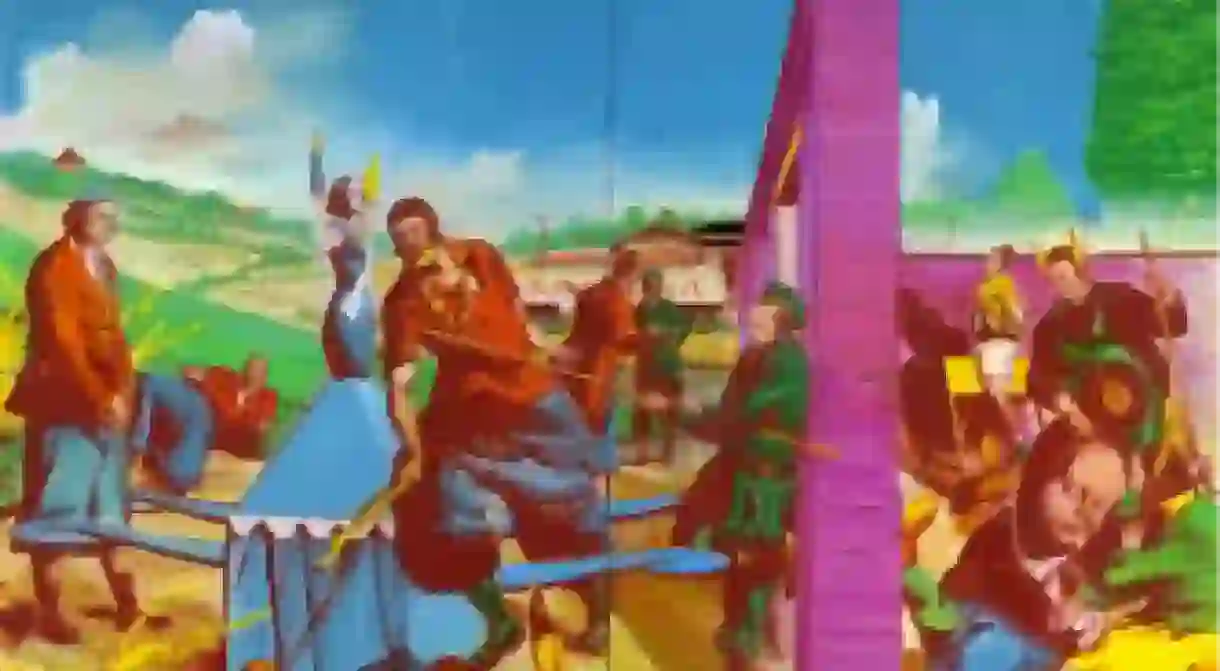Neo Rauch At The BOZAR: The Obsession Of The Demiurge

Neo Rauch is a surrealist artist whose work blends his own personal history with political narratives. Born in 1960 in Leipzig, Germany, socialist realism influences have been seen in his captivating paintings. During 2013 his work was showcased in BOZAR, representing his first major exhibition in Belgium.

© Neo Rauch, Abendmesse 2012/Bozar
Influenced by surrealism, pop art, and comic strips, as well as by his own youth and training in the old East Germany, Neo Rauch’s figurative paintings have been described as riddles without solutions. Rauch, who still lives and works in Leipzig, has had a meteoric rise to fame and his impressive paintings can now be found in the collections of major international museums.
Showcasing the work of Neo Rauch reflects BOZAR’s interest in making European and international art more widely accessible to the public and in focusing on Europe’s shared historical and cultural development. Spring 2013, the exhibitions programme focuses on artists active in times of major social change in Europe: Antoine Watteau, Francis Bacon and Neo Rauch.
Despite his international fame, Rauch’s work has not been widely accessible in Belgium. In 2010 the Belgian painter and curator Luc Tuymans selected some of Rauch’s work for a group exhibition in Bruges, Luc Tuymans: A Vision of Central Europe. The BOZAR exhibition now sets out to introduce and present the work of this major contemporary German artist to the Belgian public at large.
Neo Rauch: The Obsession of the Demiurge includes works from throughout Rauch’s career, from 1993 to 2012. As well as numerous paintings, it also includes a number of his drawings. In total it contains about 70 works that on loan from 38 different collections, including the Essl Museum (Vienna, Austria), the Pinakothek der Moderne (Munich, Germany), the Fondation Beyeler (Riehen/ Basel, Switzerland), and the Stedelijk Museum (Amsterdam, The Netherlands). The exhibition is curated by Harald Kunde, Director of the Museum Kurhaus in Kleve, Germany.
Neo Rauch’s Influences

Born 1960 in Leipzig, Neo Rauch grew up in Aschersleben in the former East Germany (German Democratic Republic). He trained at Leipzig’s Hochschule für Grafik und Buchkunst, where he later taught. Although some see echoes of the old official social realism in his work of the mid 1990s, he recalls that Beckmann, Dix, and Kokoschka were key models when he was a student. An earlier formative experience was the discovery of a volume containing reproductions of the work of Salvador Dalí on his grandfather’s bookshelf when he was twelve years old.
Another integral influence to Rauch’s work was his exposure to Western art and pop culture as a student after the fall of the Berlin Wall and German reunification.
Rauch had his first solo exhibition in 1993 and made his international breakthrough at the Armory Show in NYC in 1999. Since then he has exhibited in major museums and galleries in Germany and abroad, including the Metropolitan Museum of Art in New York, the Zacheta National Gallery of Art in Warsaw, the Albertina in Vienna, the Museo de Arte in São Paulo, and the Pinakothek der Moderne in Munich. The exhibition at the Centre for Fine Arts will be the first-ever major exhibition devoted to his work in Belgium.
Painting makes a comeback

Around the time of German reunification, and well into the 1990s, painting – and figurative painting even more so – was out of fashion. Since then, however, Rauch has been instrumental in creating a shift in its emphasis in the art world. His success has also helped to pave the way for the emergence of the painters of the “New Leipzig School”.
Rauch’s paintings, which in recent years have become more complex and monumental in scale, contain dramatic and theatrical elements with an air of mystery. His large-scale paintings draw the viewer into intriguing, mesmerizing scenes. Dream-like at times, they often contain an extensive cast of characters and hybrid creatures engaged in activities for which there is no obvious explanation. While the action is occasionally violent, there is an air of detachment that discourages identification or empathy with individual figures. Realistic rural landscapes and architecture, rooted in Rauch’s own region, form a backdrop for figures that are often dressed in early 19th-century costume or in clothing associated with industrial workers. As a result, echoes of historical events and of the history of art, including German Romanticism, are mixed with modern historical and cultural references. This fusion creates puzzling scenes that cannot be attributed to a particular time and whose significance is difficult to fathom. Rauch has stated that dreams have an important influence on his imagery.
Click here for analysis of Rauch’s work written by curator Harald Kunde.













